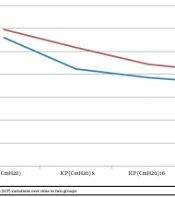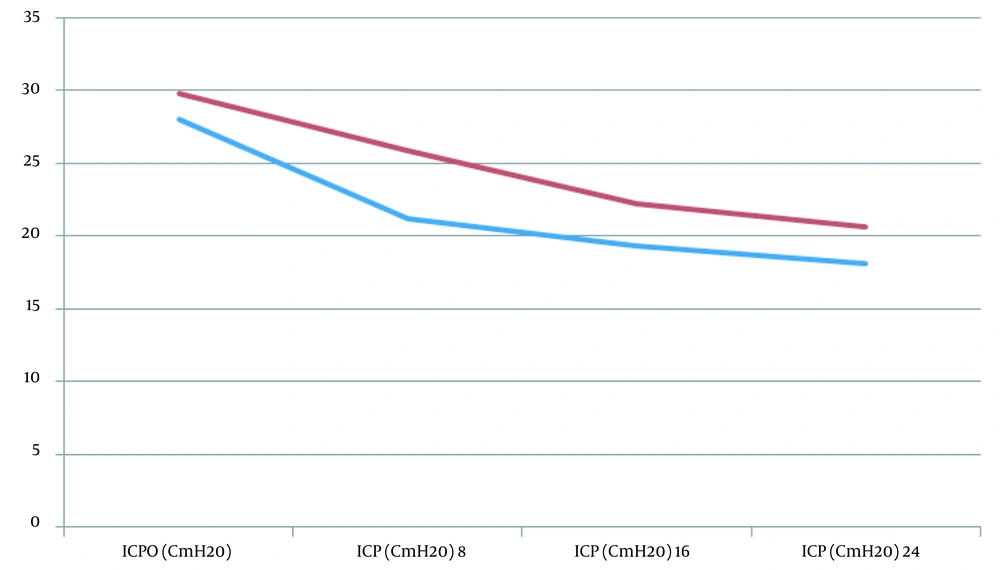1. Background
Monitoring and controlling intracranial pressure (ICP) is a critical issue in patients with severe traumatic brain injury (TBI), As patients with higher ICP are at higher risk for occurance of sever complications (1-3). In adult patients with ICP > 15 CmH20, the most common symptoms are nausea and vomiting, while symptoms such as decreased consciousness, motor paralysis, papillary edema, hypertension, bradycardia, respiratory depression usually appear in those with ICP > 20 CmH20 (4-7). Brain herniation and death may occur following the complete failure of the compensatory mechanisms and brain autoregulation (1).
Several studies have assessed the possible role of beta-blockers, including propranolol, in patients with a head injury and rising ICP, and their findings documented the significant positive effects of such beta-blockers on the patients’ outcomes (8-11). Esmolol is a short-acting, water-soluble, and selective beta1-adrenergic receptor antagonist drug with a 9-minute half-life. Esmolol is also likely to reduce intracranial pressure in patients with head trauma.
2. Objectives
3. Methods
3.1. Study Design and Setting
A case-control study was conducted at the Sina Hospital (Tehran, Iran) from June to November, 2017. The investigators did not interfere with patients' management protocol considered by the in-charge intensivist and just observed the patients and recorded the variables. The proposal of the present study was approved by the Ethics Committee of the Tehran University of Medical Sciences (Code: IR.TUMS.MEDICINE.REC.1396.4641)
3.2. Study Population
All TBI patients aged above 18 years with ICP > 20 cmH2O, who were admitted to the ICU during the study period, were included in this study. Patients with each of the following criteria were excluded from this study: patients aged above 80 years old, Glasgow Coma Scale (GCS) > 8, reactive airway diseases, recent infectious and inflammatory diseases, underlying heart, kidney, liver, and neurologic diseases, coagulation disorders, previous head injury requiring surgery, hemodynamically unstable (systolic blood pressure (SBP) < 90 mmHg, pulse rate (PR) < 60/min, mean arterial pressure (MAP) < 65 mmHg), treated with high dose vasopressors, normal initial CT scan not requiring invasive ICP monitoring.
3.3. Patients’ Management Protocol
All Patients received standard treatment, including intravenous (IV) mannitol, hyperventilation, sedation, and surgical intervention, if needed. According to the in-charge intensivist’s prescription, some patients also received esmolol orphan (manufactured by Orpha-Devel factory in Austria with serial number pl30414/0001) with an initial dose of 500 μg/kg and then 50 mg/kg/min for 24 hours (case group), and some other patients just received standard treatment without esmolol (control group). The patients were fully monitored with standard electrocardiogram (ECG) monitoring, continuous pulse oximetry, invasive blood pressure monitoring through the intra-arterial line, central venous pressure through the intra-jugular line, and ICP measurement via an intraventricular catheter. In the two groups, the ICP, PR, MAP, and SPO2 variations were measured before, 8, 16, and 24 hours after starting the treatment. All data were collected by an intensive care fellowship and recorded in a pre-prepared sheet.
3.4. Outcome
The outcomes were recorded as the length of ICU stay and mortality rates.
3.5. Statistics
The data were analyzed using SPSS software version 24. Frequency was reported for the qualitative variables, and mean, and standard deviation were calculated for the quantitative variables. Moreover, P < 0.05 was set as the significance level.
4. Results
Fifty-nine patients with severe TBI were admitted to ICU during the study period, of whom 37 patients were excluded from the study regarding the exclusion criteria. Finally, 22 patients (13 males and 9 females) were included in this study, of whom 12 patients received esmolol, and 10 patients were in the control group. The mean age of those who received esmolol was smaller than those who did not receive it (46.6 ± 18.5 vs. 62.3 ± 19.1 years; P = 0.08).
The mean age of those receiving esmolol was lower than those who did not receive it (46.6 ± 18.5 vs. 62.3 ± 19.1 years; P = 0.08). Moreover, the mean length of the ICU stay was smaller in the esmolol receivers than the control group (5.6 ± 1.1 vs. 17.3 ±7.7 days; P = 0.04). The mortality rate was 5 (22.7%); there was no significant difference between the two groups in terms of mortality rates (P = 0.30). Respiratory compromise because of bronchospasm was noticed in none of the patients.
Table 1 shows the mean values of ICP and vital signs of the patients at various checkpoints. The variations in vital signs over time were not statistically significant between the two groups (P > 0.05); however, the mean of ICP was lower in the esmolol group than the control group at all checkpoints (P < 0.05). Figure 1 also shows ICP variations over time in the two study groups. It should be mentioned that the mean of ICP before starting the management was not significantly different in the two groups (P = 0.141).
| Variable | Case (N = 12) | Control (N = 10) | P-Value |
|---|---|---|---|
| Intracranial pressure (CmH2O) | |||
| Before | 28.03 ± 0.82 | 29.75 ± 3.52 | 0.141 |
| 8 h | 21.20 ± 2.53 | 25.83 ± 3.04 | 0.001 |
| 16 h | 19.30 ± 1.64 | 22.25 ± 3.02 | 0.012 |
| 24 h | 18.10 ± 0.99 | 20.58 ± 3.55 | 0.045 |
| Pulse rate (beat/min) | |||
| Before | 82.31 ± 6.46 | 82.42 ± 8.24 | 0.971 |
| 8 h | 80.60 ± 8.57 | 85.75 ± 12.86 | 0.293 |
| 16 h | 82.43 ± 8.97 | 83.58 ± 10.80 | 0.785 |
| 24 h | 80.11 ± 7.55 | 81.02 ± 8.87 | 0.803 |
| Mean arterial pressure (mmHg) | |||
| Before | 99.71 ± 12.01 | 102.82 ± 25.95 | 0.729 |
| 8 h | 90.93 ± 11.78 | 100.30 ± 16.36 | 0.148 |
| 16 h | 92.50 ± 11.70 | 94.73 ± 14.01 | 0.699 |
| 24 h | 92.54 ± 8.71 | 88.03 ± 17.07 | 0.463 |
| Blood oxygen saturation (%) | |||
| Before | 96.61 ± 2.59 | 98.30 ± 1.78 | 0.078 |
| 8 h | 96.03 ± 2.68 | 97.33 ± 2.57 | 0.248 |
| 16 h | 95.70 ± 2.63 | 96.92 ± 2.68 | 0.297 |
| 24 h | 97.13 ± 2.08 | 96.67 ± 2.06 | 0.63 |
Mean Values of ICP and Vital Signs of the Patients at Various Checkpoints a
5. Discussion
In the present study, the mean of ICP over time was lower in those receiving esmolol than those undergoing the standard treatment without esmolol. Moreover, the ICU length of stay was shorter in the esmolol group than the control group. While, the variations in vital signs, including PR, MAP, and SPO2, was not different over time in the two groups.
TBI is one of the most common indications of intracranial pressure measurement. Increased intracranial pressure in patients with TBI leads to most deaths. Sometimes, the best treatment may not be possible to eliminate the underlying cause of intracranial pressure. Esmolol is a selective beta1-adrenergic antagonist specific to the cardiovascular system, with the rapid onset of action and the short duration of action with few effects on bronchial receptors. Esmolol seems to decrease intracranial pressure by reducing blood pressure. Due to its short half-life, this drug is efficient in reducing intracranial pressure in patients with trauma (17).
The beta-blocker agents have a significant therapeutic effect on reducing blood pressure and intracranial pressure in patients with traumatic brain injuries. In most studies, Propranolol is a competitive β1 and β2 adrenergic receptor blocker, with a 5-10 minute onset of action and a half-life of 2 - 5.5 hours after the IV administration. Such a long half-life raised some concerns regarding its suitablity for managemnet of ICP raising in TBI patients. However, the findings of the present study revealed that esmolol as a short-acting selective beta1-adrenergic receptor blocker with a short half-life (it has about 10-30 minutes' duration of action and 9 minutes' half-life) has significant therapeutic effects on the ICP control in the setting of TBI and is associated with no respiratory and hemodynamic complication. Esmolol was selected to be examined in this study because of the shorter duration of action and the absence of side-effects compared to other beta-blockers.
5.1. Limitations
The small sample size was the main limitation of the present study. This was not an interventional study, and a randomized clinical trial is definitely required to follow this preliminary observational study.
5.2. Conclusions
The patients with TBI who received esmolol as part of their ICP control in ICU had lower ICP compared to those not receiving this agent.

